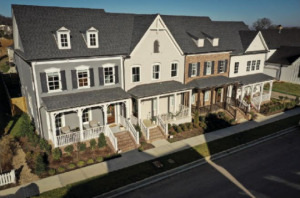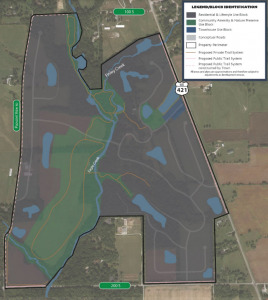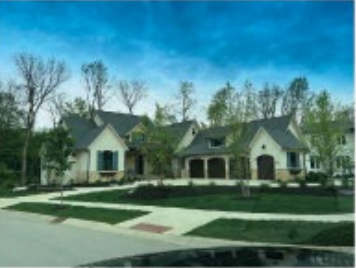Subscriber Benefit
As a subscriber you can listen to articles at work, in the car, or while you work out. Subscribe NowWestfield-based Henke Development Group LLC is planning a 350-acre nature-focused residential and recreational development in a rural area on the north side of Zionsville that would include single-family houses, townhouses and a private park with trails.
Bradley Ridge would be bounded to the east by U.S. 421 (Michigan Road), to the south by County Road 100 South, to the west by County Road 950 East (Pleasant View Road) and to the north by County Road 200 South.
The development would be bisected by Eagle Creek with approximately 74 single-family houses on the west side of the creek. A yet-to-be-determined number of additional single-family houses and about 60 townhouses would be built on the east side of the creek.
Matt Price, an attorney representing Henke Development, told the Zionsville Plan Commission on Monday night that single-family houses would range from $1 million to $3 million, and townhouses would cost $800,000 to $850,000.

Price said Henke Development estimates the total assessed valuation of the project, if it is built according to current plans, would be more than $700 million.
Bradley Ridge would also have a 60-acre private park that would include trails, greenways, a community building, a cabin and space for archery, camping, golf practice and pickleball.
The topography of the site near Eagle Creek includes a hilly landscape and multiple lakes and ponds.
“It’s really just unique topography and nature, and that’s what we gravitate towards with our developments,” Brad Henke, who handles development and brokerage for Henke Development, told IBJ. “And this would be the same. Just a really high-quality, upscale development that is really centered around nature and Eagle Creek.”
Henke Development is in discussions with the town of Zionsville to extend a trail along County Road 950 East to Carpenter Nature Preserve, which will be built north of the proposed Bradley Ridge development at the former Wolf Run Golf Club.
The first phase of construction at the 215-acre Carpenter Nature Preserve on the southwest side of the intersection of Michigan Road and State Road 32 will be completed by late 2025 or early 2026 and include trails, parking and restrooms. Future plans call for a nature center and an outdoor classroom.
The preserve will also have enhanced wetlands, woodlands and prairies, along with boardwalks, a nature-inspired playground and Eagle Creek overlooks.

“It’s rare to find rolling hills and undulation like that in this area of Indiana this close to Indianapolis,” Henke said. “I think we’re always drawn to really pretty land like that.”
Utilities will need to be extended north to Bradley Ridge if the development receives approval. Henke Development commissioned a traffic impact study that will be presented to the town when it is completed.
The developer petitioned to rezone the nine-parcel site from rural general agriculture, rural single-family residential and rural single- and two-family residential and within the Rural Michigan Road Overlay to the Bradley Ridge Planned Unit Development.
The Zionsville Plan Commission will continue to discuss the development at its meeting on Aug. 21.
While some residents spoke in support of Bradley Ridge at Monday’s meeting, others expressed concerns about traffic, the development’s impact on nature and a lack of notice in receiving information about the project.
Bradley Ridge would be Henke Development’s third major residential project in Zionsville.
Holliday Farms is a 600-acre golf community west of Michigan Road, between Willow Road and 146th Street in Zionsville. The overall project is expected to be completed over the next decade with eight planned neighborhoods and a Pete Dye-designed golf course that opened in June 2021.
Construction began last year on the 321-acre Promontory of Zionsville, which would include 80 single-family homes ranging in cost from $1.5 million to $4 million. A 35-acre lake will be the focal point of the project, which also will include equestrian fields, stables, walking paths and open space.
Please enable JavaScript to view this content.


Just what we need, more sprawl of million+ homes (and townhomes?) well beyond the current edge of town. Nothing says Nature like Car-Dependent Suburbia!
Agreed. If you build it they will come. We’re just building the wrong type of real estate right now and it’s unfortunate.
Indeed. And the costs of extending utilities and other infrastructure to the area will no doubt be high.
Better nice homes than cookie cutter vinyl siding homes that many builders destroy communities with…
Charles wants the land to be undeveloped. Is that correct? What do you consider to be the “current edge of town”? Jason and Riley think this is the “wrong type of real estate”. I am curious what type development would you prefer?
Buyers who can afford these homes would pay for green technology, but as with most of these giant developments, there will be no push to install solar or use any other technology that could reduce the carbon footprint. More run off, acres of black rooftops and asphalt, yet more pesticide-laden lawns. Way to go, Henke. Way to go, Zionsville.
I don’t understand why a person would want to live in a townhome in the middle of a former cornfield. A townhome that is in easy walking or biking distance to something other than other houses in a former cornfield — sure. But why live right on top of other people in the middle of nowhere? And to pay almost a million dollars for the privilege to do it?! And Andrea S has a good point as well — this is being sold as “nature” but is still probably the exact same “high-end” yet still junk mechanical systems that require a 320 amp service to the home to run, and a bunch of spray-foam insulation and other materials that will be offgassing who-knows-what into a “tight envelope” house for who-knows-how-long.
Agreed. The root issue right now is the cost of construction. Home builders simply can’t/won’t build affordable housing. The $800K townhouses sold as “nature” is all we’re getting. It’s not really sustainable construction and it’s not affordable for first time home buyers. It’s a rock in a hard place.